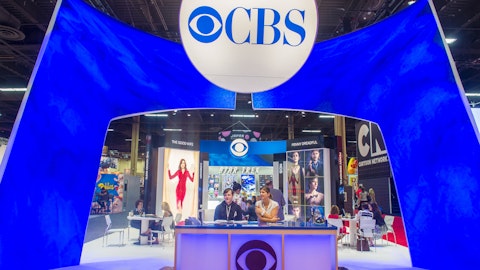Craig Huber: Okay. And then also, on your local news ratings, early morning news and maybe late night, can you give us a sense on how those ratings trends are going to get separate the two, early and late day?
Pat LaPlatney: So — yes, our — look, we have a bunch of good television stations. And I can’t sit here and tell you that there’s this dramatically — dramatic spike up or down. The numbers are large and continue to be large. Morning news, there was a little bit of noise in morning news numbers around COVID. And — but we’re back sort of returned. Do you have any thoughts on that, Sandy?
Sandy Breland: Yes. It’s kind of — we are back to normal there. But we have seen in some — especially in some of our larger markets, and quite frankly, some of the former Meredith markets where we’ve seen our audience in the morning news grow significantly. And we’re very — we’re very pleased with that. And the same, I would say, for late news as well, we’re seeing that in several of those markets.
Craig Huber: Sorry. So you suggest maybe versus pre-pandemic 2019 levels, the ratings are, say, flat or up?
Pat LaPlatney: No. We’re just saying there’s been a bit of a normalization. And we’re also saying that in the Meredith markets, which are the larger markets we have, we’re seeing audience growth in a number of those markets.
Craig Huber: Okay. My last question, if I could, this ongoing Hollywood strike. If this thing continues here, do you anticipate any negative ramifications for your TV stations here?
James Ryan: This is Jim. I’ll start off and Pat or Sandy are welcome to join in, but we don’t see that as a significant headwind one way or the other. Obviously, it will have — to a modest degree, we think some impact on Prime Time as we move through the fall. Obviously, it will all depend on how quickly the strikes are settled. And as Hilton said, we hope that they’re settled amicably for all parties concerned sooner than later, but any strike eventually gets settled. We don’t — given the limited amounts of inventory that we have available to sell Prime Time, the impact to us as we move through September and fourth quarter is not significant at all. I mean, we’ve seen it before. It’s not a big deal, given again the local broadcast niche that we occupy, we are not a network. So — it’s not a super big deal to us.
Craig Huber: Great, thank you.
Operator: And our last question is going to come from Jim Goss with Barrington Research. Your line is open.
James Goss: Thank you. One more on the sports programming. You’ve been talking about with Phoenix and the ACC. You’re making compelling arguments for getting involved, and they do understand it’s early stages in trying to figure this all out. But I’m wondering how far you do plan to take this, how extensive this effort might be? And I assume there’s pretty good competition for those rights locally, and comment on that. And the for the big issues obviously seem to be how does it fit into network scheduling because you’re — in all of the areas where you have a network feed, it would interrupt a Prime Time in a lot of cases. I’m just wondering how it blends with that sort of situation.
Pat LaPlatney: Yes. Sure. I’ll start, Jim. It’s Pat. So we have a number of independent television stations in larger markets. Phoenix happens to be one of those markets. So in markets where we have these independents, it’s not a problem. It’s a great opportunity. And then I think what you’ll see on affiliated stations is the use of the subchannels to carry these games. So there’s not just the CBS affiliate, but there’s other channels that we air where it would be — there would be no issues carrying pro sports games. So there’s — it’s going to vary by market, but particularly in larger markets where we do have independents, which include Phoenix, Atlanta, Portland, we have two signals in Cleveland. There are great opportunities, and there should be great opportunities in those markets.
James Goss: Okay. And one last thing. After years of scaling up your platform and developing Assembly Studio and a variety of other things. Do you have any further growth ambition beyond focusing on your high-quality expanded platform, say, for the other 3% and get into the cap limit? Or are you sitting still for a while and just evaluating what you’ve been undertaking?



